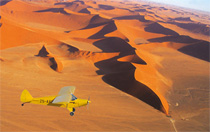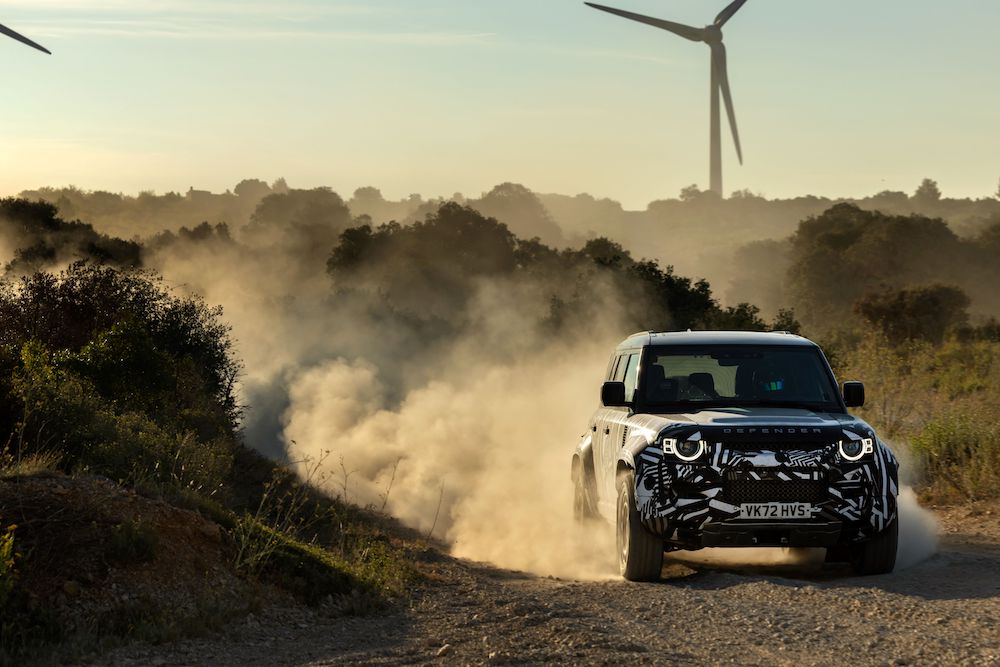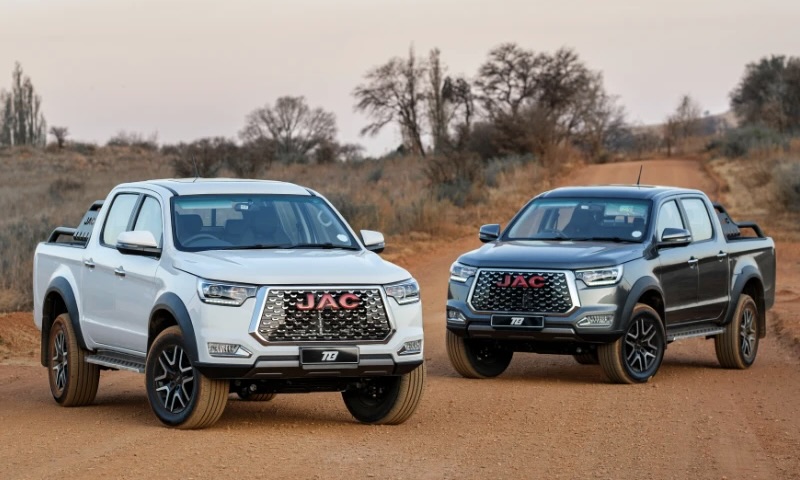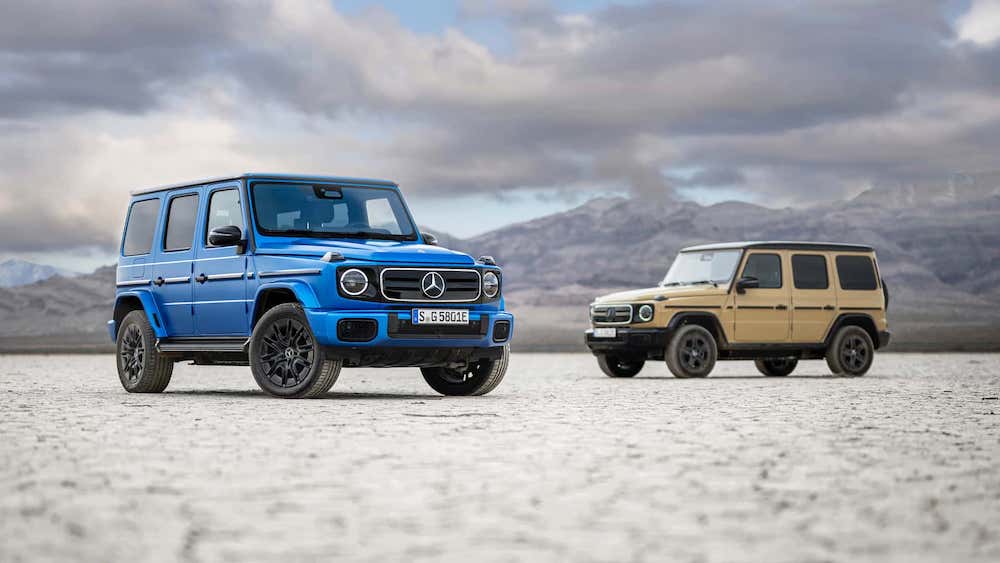Text: Danie Botha
Photographs: Derick Lategan, Johnie Smith
It started with a phone call about an air show, between long-time friends Derick Lategan, owner of African Outdoor Group (AOG), and Johnie Smith, owner of Johnie Smith Crop Dusters.
Both men are highly experienced pilots and have been flying for donkey’s years. Derick and Johnie work under extreme pressures – and that became a topic of conversation.
“I’m so fed-up with everything, I feel like I want to climb into an aeroplane and just fly until the sea forces me to turn around,” said Derick to his friend on that day in June this year.
“I know exactly how you feel. Okay, so what’s stopping us from actually doing it?” enquired Johnie.
“Well, I’ve got…” began Derick.
“Let’s just do it,” retorted Johnie. “Let’s go to Namibia, and have ourselves a week of flying, exploration and adventure!”
Sitting in his office at AOG’s headquarters near Hartbeespoort dam, Derick laughs about that phone call.
“By the end of the call we had agreed to meet at Vryburg airport on a Thursday afternoon, each in his own aircraft, and that we would tackle Namibia from there. And that was the extent of our route planning for this trip!”
Derick’s Piper PA-22-150 Tri-pacer and Johnie’s 1947 Piper Super Cruiser were loaded with fridges, camping gear, clothing, braais, charcoal, and lots of food.
“On the Thursday I still had to work on a media launch, and it was also the same day that Boeing 737s were being diverted away from Lanseria to OR Tambo International airport, because of adverse weather conditions. But with my girl (the plane – Ed) loaded up, and with special visual flying rules (VFR) clearance, I departed from Lanseria to Vryburg, arriving just as the sun was dipping below the horizon.”
Johnie had flown in earlier from his farm near Frankfort in the Free State. That night, with both planes refuelled, and with a cold one in the hand, Derick and Johnie discussed the next day’s plan of action.
“We decided to head to Upington to do the passport stamping and customs clearance there, and then to the Keetmanshoop airport in Namibia, to complete the administration process. From there it was on to the Fish River Canyon and the Ca¤on Lodge, where we would spend our first night in Namibia,” explains Derick.
Planning their route in this shooting-from-the-hip fashion was only made possible by Aviation Direct’s EasyPlan computer programme, and flight maps of Namibia.
“There is absolutely no existing information available to do a trip like this with an aeroplane. So the computer programme and the maps became our best friends!” says Derick.
By 6am the next morning, ZS-CJP and ZS-AXX were airborne. The adventure was officially underway.
The first stop at Upington went without any hitches, and soon the two planes were over the border, landing at Keetmanshoop.
“This airport used to be an international one, but now one single soul is the air traffic controller, the cleaner, the refueller, everything. His name is Alfred, and he was extremely helpful. It’s a large premises, but completely deserted. Big fire trucks are parked in hangers, unused. Alfred phoned the customs officials, who had to come from Keetmanshoop town to do the paperwork,” says Derick.
With their passports up to date, the two men took off in formation again.
“One of the advantages of our ‘bush planes’ is that we can land just about anywhere, and take off again in very short distances. So when it was time for lunch, we found a suitable lunch ‘strip’, landed, took out the food, and had lunch. The same went for morning and afternoon tea!”
That afternoon they touched down at the Karios settlement’s dusty airstrip, and were whisked away to the nearby Ca¤on Lodge. That evening, after talking to the friendly staff, they realised they would be facing another major challenge: fuel.
“From there on our route was no longer planned around what we wanted to see, but rather what we would be able to see en-route to the next fuel stop,” laughs Derick.
The next morning the two adventures left Karios for the Fish River canyon, flying low, sometimes in the valley between the huge cliffs.
“In a car or on foot this place certainly leaves you in awe. But from the air it is something completely different, something words and photographs can’t really capture,” remembers Derick.
After the canyon the two planes headed to an extremely windy Lderitz for refuel. This airport was yet another one-man operation, and the “restaurant” offered a selection between Fanta… and Coke.
From there they turned east again, to go in search of the wild horses in the Aus area.
“We flew on Instrument Flight Rules, but not the usual IFR. Instead we used the I Follow Road method, tracking the main road from Lderitz to Aus!” jokes Derick. “We found the horses too. It is amazing to see these animals in such good condition, in a place that looks like it shouldn’t be able to support any form of life.
“It was also important for us to do our game viewing from the air responsibly. It would have been very easy to be naughty and chase the animals around, but we rather kept our distance, and tried not to spook them.”
At Aus the two planes turned north, to Sossusvlei and the desert.
“Landing at the Sossusvlei air strip, we were met by die Sossusvlei Lodge personnel, and the planes were also refuelled. I must say that Johnie and I can’t stop talking about the attitude of complete strangers in Namibia. It’s like you are family members who have returned home after spending years in the wilderness,” enthuses Derick.
That night a female pilot from the area informed the two intrepid travellers that their best bet to find more fuel would be at Palmwag, for an overnight stop. So, after a comfortable night at the lodge the two men aimed their planes’ noses towards the Skeleton Coast.
“It was really spectacular to see attractions such as the famous Dune 45 and Sossusvlei itself from the air. And those dunes… they’re a sight to behold. We soon reached the coast, though, with the aim of finding old mining camps as we headed north up the coastline towards Walvis Bay. For the first time I also fully realised why this wild place is called ‘Skeleton Coast.’ We saw so many shipwrecks along the way, we eventually stopped counting!
It is indeed littered with the skeletons of ships.”
They also found the deserted mining camps, and thousands of seals along the way, as well as Pelican Point. The pair of Pipers touched down at the Swakopmund airport – a major surprise, as it caters for the huge influx of tourists to this area.
“They even had a restaurant that served food!” jokes Derick.
From Swakopmund the planes continued north up the coast, past Hentie’s Bay. When the two pilots reached Cape Cross, with its famous cross that was erected by Portuguese settlers in the 16th century, the planes went east again – in search of the next refuel.
Lunch was enjoyed under the planes’ wings at the landing strip at Ameib Ranch near the edge of the Erongo Mountains. The two men enjoyed tea, biltong, and a lunch pack provided by Sossusvlei Lodge.
Next on the “to do” list was the famous Brandberg, and from there the two vintage aircraft cruised along at a sedate 160 km/h to Palmwag.
“After Brandberg the landscape became increasingly harsh, and remote. Yet there was a surprising amount of greenery after summer’s good rains, as well as a horde of animals along the way. But the highlight on this leg was the desert elephants, which we found just before Palmwag. We didn’t hang around too long though, as they were getting restless.”
At Palmwag they met yet another female pilot, based there. “There seem to be a lot of ladies flying in Namibia!” says Derick. “Besides giving us some pointers on possible fuel stops farther north, Kirsty also helped sort out a problem Johnie was experiencing.”
The Perspex side window of Johnie’s Tri-pacer flew out in mid-flight, after he accidentally bumped it with his elbow.
“Our ‘ladies’ don’t have air-conditioning, so during the day when it is piping hot, we obviously open the sliding side windows. But late afternoon or early in the morning, when it is chilly, we prefer them closed.”
A plan was hatched. The two men scrounged through the lodge’s scrap yard, and found a piece of Perspex that roughly resembled the Piper’s side window. It was an old window from a Land Rover, which the pair made fit into the hole on Johnie’s plane.
“If I have to select only two items to take with me into Africa, it would be toilet paper, otherwise known as white gold, and duct tape. We used the duct tape to good effect,” says Derick.
After a sociable evening at the lodge, gathering more information on available fuel resources, Derick and Johnie decided to make Epupa Falls their next main target. In the process they would take the opportunity to visit the Kunene River mouth too.
“We refuelled at the Opuwu airport, then headed straight for the Kunene River mouth. When we arrived there the wind was howling. Interestingly, a kind of bunker system was built to store aircraft at the small Kunene airport. Apparently this is due to the winds… if the planes are not protected, the wind and sand will literally sandblast the paint off the aeroplanes!”
Epupa Falls was their next stopover. After flying over the Epupa Falls they headed back to Opuwu for a refuel, and then set the GPS systems for Ermo Game Farm, a private reserve next to the Etosha National Park. They landed on the dusty “runway”, and set up camp next to a farm dam, on a patch of concrete.
“It was our first night of wild camping, but we were prepared. The braai, the beer, the charcoal, the sleeping rolls under the wings. So we had a grand braai with lots of meat, a couple of Tafel lagers… life was very good at that moment. Then we went to sleep, and the, um, trouble started,” says Derick.
With the campfire burning, and the two men ensconced in their sleeping bags, they heard the sound.
“Lying there, we went through the entire animal kingdom sound catalogue, but we couldn’t figure out this weird sound. It came closer, and closer. To say that I was scared would be to betray my fellow man. Let’s rather say I was feeling progressively more uncomfortable,” laughs Derick now.
So the men packed every object they could find around them. Cooler boxes, fridges, bags. And they had their weapons at the ready: a catapult (kettie) each, and a bag of marbles.
“Johnie normally doesn’t have any difficulty sleeping, but at 1am the next morning he was still getting up whenever the fire started to die, to add some more wood. I realised I was not the only one feeling uncomfortable!”
The night passed without incident, though, and the next morning they went for a wash at the nearby farm dam. On their way back, they saw it: the spoor of a very large cat. They followed the spoor, and it led them to within metres of where they had slept.
“Later that day we showed the pics of the spoor to local farmers, who confirmed that it was a very large leopard. When we told them that we did manage to keep the campfire burning to keep any predators at bay, they nearly laughed their heads off. We asked what the joke was, and they said that, of all the big cats, the leopard is the only one who is not deterred by a fire. Not in the least little bit!”
The men were soon airborne again, on their way to Tsumeb, for a refuel. From there they stopped over at Eros Airport in Windhoek, just because they wanted to see what it was like.
“Our two little bush planes were parked amidst all these new machines, including a pink Pilatus PC12. The friendly people at the airport who helped us insisted that we stay for a beer and for dinner, but we decided Eros was no place for us. We wanted to be in the bush. So we got out the flight maps and the laptop computer. We calculated that we had about an hour’s worth of flying time left before darkness, and drew a ‘one hour’ circle with Eros in the middle on the map. Bitterwasser, which had a landing strip, was the decision, and we headed out,” explains Derick.
With the sun fast heading towards the horizon, and with the landing conditions at the destination completely unknown, there was a tense atmosphere in the cockpits.
“We arrived at the airfield in near darkness. There were obviously no landing lights. Our vintage planes’ lights are not exactly super strong. Johnie went in first, and had no hassles.”
But then, as Derick lined his Piper up and began his final approach, a frantic radio message came over the radio. It was Johnie.
“Trouble! Max power! Pull up! Pull up!”
Derick reacted immediately, pulling up under maximum power… and it probably saved his life. Using a different runway to Johnie, he could not see a fence running across the runway. Johnie only saw it at the last moment too. Fortunately he did…
“I had just rolled to a stop after putting the girl down safely, when a Mercedes ML pulled up next to the plane. And the next moment a horse and its rider arrived, in near darkness. She was a beautiful girl, and it was quite a surreal moment. Close call, funny man in ML, beautiful girl on horse.”
Bitterwasser was a revelation. The little airstrip they saw on the flight map was the Bitterwasser Lodge and Flying Centre, one of the world’s top glider plane venues. The next morning Christine, the lady on the horse, showed them the massive hangers full of the latest and greatest gliders.
After enjoying the lodge’s excellent hospitality, Derick and Johnie departed from Bitterwasser with a bit of sadness. They had never expected to find a place like this in the middle of nowhere. Their next fuel stop was the farm Langverwacht, following directions from the Bitterwasser staff. Oom Marnus, the farm owner who has his own light plane, was quite a character.
“When we landed, the Ford F250 with the AVGAS fuel was waiting, and our planes were refuelled. When it came to payment, Oom Marnus at first refused any payment. Only after doggedly insisting to pay, he charged us about R10 per litre. And we had paid up to R23 per litre up to that point! We couldn’t just leave either. First we had to have some coffee and KOEKSISTERS. This again just showed how friendly these people are. In South Africa, you don’t often find this kind of attitude anymore,” says Derick.
After bidding Oom Marnus farewell, the duo took off. Next destination: Koes, where a few of Johnie’s friends were hunting.
“That night we had a great time, what with all the hunting stories and the campfire. It was a good old KUIER. But we also realised we had a bit of a problem, and it had everything to do with fuel again. Although the planes’ fuel tanks were still more than half full at that stage, it would not be enough to take us all the way to Keetmanshoop to do the necessary paperwork before leaving Namibia. So, of course, we made a plan,” says Derick.
The next morning the local traffic and police departments were consulted, and permission granted to taxi the two vintage planes into the town of Koes, to the local co-op and the Total filling station.
“It caused quite a stir, and every single living being in Koes was there to watch the two planes taxiing down the main dirt road. They came on foot, by car, and by horse. It was a heck of a thing!” laughs Derick.
With brimming tanks, the planes took off for Keetmanshoop. There the paperwork was completed, and the two machines headed south across to border, to Upington, then Vryburg, and finally, Derick touched down at Lanseria International Airport.
The two vintage planes had covered 6750km on their weeklong adventure.
Would he do it again?
“Just talking about it makes me want to climb into an ‘aerie’, and go and do it again. And again, and again. We’re talking about Botswana next. Then Mozambique, then…”
Okay, okay Derick. You obviously enjoyed it.
“You bet. So much so that Johnie and I are talking about taking people on aerial safaris like this, in our bigger planes (yes, they’ve got bigger ones too – Ed). It’s completely and utterly different to seeing these wonderful places from a 4×4. I said it a while back, and I’ll say it again: to my mind the best way to go overlanding through Africa, is by plane.”
Nuff said. For now.
1947 Piper PA-12 Super Cruiser
Engine: 3829cc, four-cylinder, air-cooled, horizontally opposed
Power: 110 kW @ 2800 r/min
Empty weight: 432kg
Max takeoff weight: 795kg
4×4 system: 800×6 balloon tyres
Suspension: Nope
Fuel capacity: 121 litres
Average consumption: 18,9 litres/100km
Range per tank: About 640km
Price: About R550 000
1958 Piper Tri-pacer
Engine: 3829cc, four-cylinder, air-cooled, horizontally opposed
Power: 110 kW @ 2800 r/min
Empty weight: 555kg
Max takeoff weight: 1 ton
4×4 system: 800×6 balloon tyres
Suspension: Nope
Fuel capacity: 152 litres
Average consumption: 18,9 litres/100km
Range per tank: About 804km
Price: About R425 000









